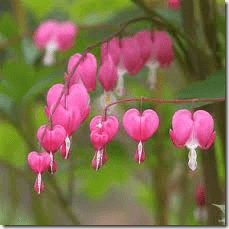-
Bleeding heart (Dicentra spectabilis) is a woody perennial with deeply-lobed leaves and unmistakable, pink-and-white heart-shaped flowers. It prefers to be left undisturbed in rich, cool, moist soil, and, although it is hardy in U.S. Department of Agriculture zones 1 to 9, bleeding heart often dies back in hot weather. As a relatively large perennial, growing 2 to 3 feet tall and just as wide, a fading bleeding heart leaves quite a gap in the shade garden. Larry Hodgson, author of "Perennials for Every Purpose," suggests companion plants that keep bleeding hearts content and complement their texture.
Hostas
-
 Some gardeners populate their entire shade garden with hosta specimens.
Some gardeners populate their entire shade garden with hosta specimens.Hostas (Hosta sp.) have a wide range of color, texture and size. The broad, pointed leaves may arch, curl or have a quilted texture. Leaves are often deep green, but bright green varieties like ‘Gold Edger’ are available, as are white or yellow variegated plants like ‘Patriot.’ Give larger varieties, like the 5-foot-wide ‘Sum and Substance,’ adequate room for its mature size, preventing the need to move the hosta or the bleeding heart. Hosta’s mounds of wide leaves contrast nicely with the arching, fern-like texture of bleeding hearts, and both plants prefer shade, regular water and fertile soil. Hostas are hardy to USDA zones 3 to 9.
Red Barrenwort
-
 Nurseries usually sell barrenwort under the botanical name, epimedium.
Nurseries usually sell barrenwort under the botanical name, epimedium.Red barrenwort or red epimedium (Epimedium x rubrum) is a low-growing perennial that, as it spreads, becomes an effective groundcover. New growth is often red-tinged, and when temperatures drop in fall, the heart-shaped foliage turns an attractive red-bronze. Like bleeding heart, barrenwort prefers partial shade and moist, fertile soil. This shade-lover also tolerates dry conditions once it is established and is an ideal choice for sun-to-shade transitional areas. In spring, the four red sepals frame each white flower, giving this plant the nickname "fairy wings." Red barrenwort is hardy in USDA zones 5 to 9 and grows 8 inches high and 12 inches wide.
Pulmonaria
-
Despite the unattractive common name of lungwort, pulmonaria (Pulmonaria sp.) is a lovely addition to the shade garden. Variegated cultivars light up darker areas, and the flowers may be blue, purple, white or pink. Pulmonarias spread through rhizomes and grow 9 to 18 inches high and up to 3 feet wide. Dozens of varieties exist, including ‘British Sterling,’ with silver, oval leaves edged in green, and "Pierre’s Pure Pink,’ with green leaves sporting silver polka-dots. Pulmonaria is hardy in USDA zones 3 to 9 and prefers the same conditions as bleeding heart.
Siberian Bugloss
-
 Shade gardens light up with a variegated brunnera.
Shade gardens light up with a variegated brunnera.Also known as brunnera, Siberian bugloss (Brunnera macrophylla) is a smaller perennial for the front of the shade garden. The narrow, heart-shaped leaves grow up to 8 inches long and make neat mounds roughly 18 inches high and 24 inches wide. In spring, the plant is covered with small, five-petaled lavender flowers. ‘Dawson’s White’ is a strikingly variegated form, with leaves edged in white, adding light to shady areas and contrasting with bleeding heart’s emerald green foliage. Bugloss is hardy in USDA zones 3 to 9 and, like bleeding heart, needs steady moisture and light shade.


Deprecated: strpos(): Passing null to parameter #1 ($haystack) of type string is deprecated in /home/agriviek8Qv/agriviet.net/public_html/wp-includes/comment-template.php on line 2522